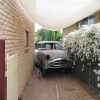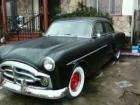|
Re: Interesting valve testing proceedure
|
||||
|---|---|---|---|---|
|
Forum Ambassador

|
Well, if bubbles appear and you're holding the valve really tight on the seat, then you're loosing compression so a valve job maybe in your future. As to the method with the oil, never used it but it seems not unreasonable. Just remember the valve spring will hold the valve closed far more tightly than you will be able with your hand, so be prepared for the possibility of some false results.
Posted on: 2013/2/11 12:59
|
|||
|
||||
|
Re: Interesting valve testing proceedure
|
||||
|---|---|---|---|---|
|
Home away from home
|
With this air test, the springs and keepers remained in place, so there is full spring pressure holding down the valves. Valves are now all out, that was another job, like the head removal, which turned out be quite manageable. Will at a minimum, lap all the valves. The next question are the valve guides. All the valves,after removing springs, have a slight lateral movement when holding valve face about 1" above block, does this mean new guides?
Thanks again for everyone's advice.
Posted on: 2013/2/11 19:32
|
|||
|
||||
|
Re: Interesting valve testing proceedure
|
||||
|---|---|---|---|---|
|
Home away from home

|
Dear Bill:
You already know the condition of the valves from the compression test. After that the best way to determine cylinder leakage is with a tester that screws into the spark plug hole and uses compressed air. Sorry to hear about the bent valve. You can make up a facsimile of the official Packard head removal tool if you take a spark plug to the auto supply and match it up with some long bolts that can be used to make a pair of lifting handles that screw into the spark plug holes. That will help prevent damaging parts during head removal. As for the guides, you need an expanding ball inside diameter tool available from McMaster-Carr and a micrometer. From there you can calculate/measure the clearance, but there will always be rocking motion in the valves because the guides are so long that .004 will feel like a lot of clearance. It is more important to make sure the guides are clean and the valve stems free of pitting that collects varnish.
Posted on: 2013/2/11 21:23
|
|||
|
||||
|
Re: Interesting valve testing proceedure
|
||||
|---|---|---|---|---|
|
Home away from home

|
Bill. just one point about valve guide clearance . . . .
It's wonderful to have a perfectly spec'd engine with 'minimum clearances' as per the workshop manual. But I would ask myself: "Would I rather have a seized / bent valve or an engine that I could rely on?". If you have valve guide clearance that is a thou (or two) over the spec you MIGHT use an extra pint of oil per thousand miles but if you happen to seize / bend a valve (- and there are quite a few reports of that happening in Packard engines) then you have real problems, like an expensive engine rebuild. Tolerance in valve guides is (IMHO)not a key critical issue unless the valve stems and guides are badly worn / valves not centred on seats / wobbling because out of round etc. Sure, you don't want unrealistically large clearances but a little over spec is better than a jammed valve. As mentioned by Tim, you will detect rocking motion but that might be just reasonable wear. Suggest accepting the maximum allowable tolerance, as that shouldn't be a bad decision. Seat / lap valves in well for the sake of good compression and don't be too concerned about the guide tolerance, provided it is reasonable.
Posted on: 2013/2/12 7:30
|
|||
|
1951 Packard Club Sedan | [url=ht
|
||||
|
||||
|
Re: Interesting valve testing proceedure
|
||||
|---|---|---|---|---|
|
Home away from home
|
Thanks, I feel much more confident now in just inspecting guilds an making sure they are clean (say with a "Qtip" and some acetone or is there a better method? What should I be looking out for regarding the valves stems themselves, plan to wire wheel the carbon off the face and underside of valves.
Posted on: 2013/2/12 10:29
|
|||
|
||||
|
Re: Interesting valve testing proceedure
|
||||
|---|---|---|---|---|
|
Home away from home
|
Bill, you might look into using a gun cleaning rod and solvent to clean-up the valve guides.
(o{}o)
Posted on: 2013/2/12 11:10
|
|||
|
We move toward
And make happen What occupies our mind... (W. Scherer) |
||||
|
||||
|
Re: Interesting valve testing proceedure
|
||||
|---|---|---|---|---|
|
Forum Ambassador

|
I agree generally with Larry51 that it's not always necessary to fit parts to a "factory-fresh" specification in order to get a serviceable result - lots of service parts that would have been needed sometime in the future have been needlessly consumed by some who believe in replacing everyhing in sight regardless of condition. But it doesn't pay to deviate too far from specification for exhaust valve guides and most especially if you're going to power-grind the seats. The problem becomes that the pilot pin for the power grinder probably won't find the true center line of the guide bore and thus you run the risk of grinding seats off-center with respect to the guide center. The result may be a very unsatisfactorily short valve life and battered seats.
Posted on: 2013/2/12 12:29
|
|||
|
||||








